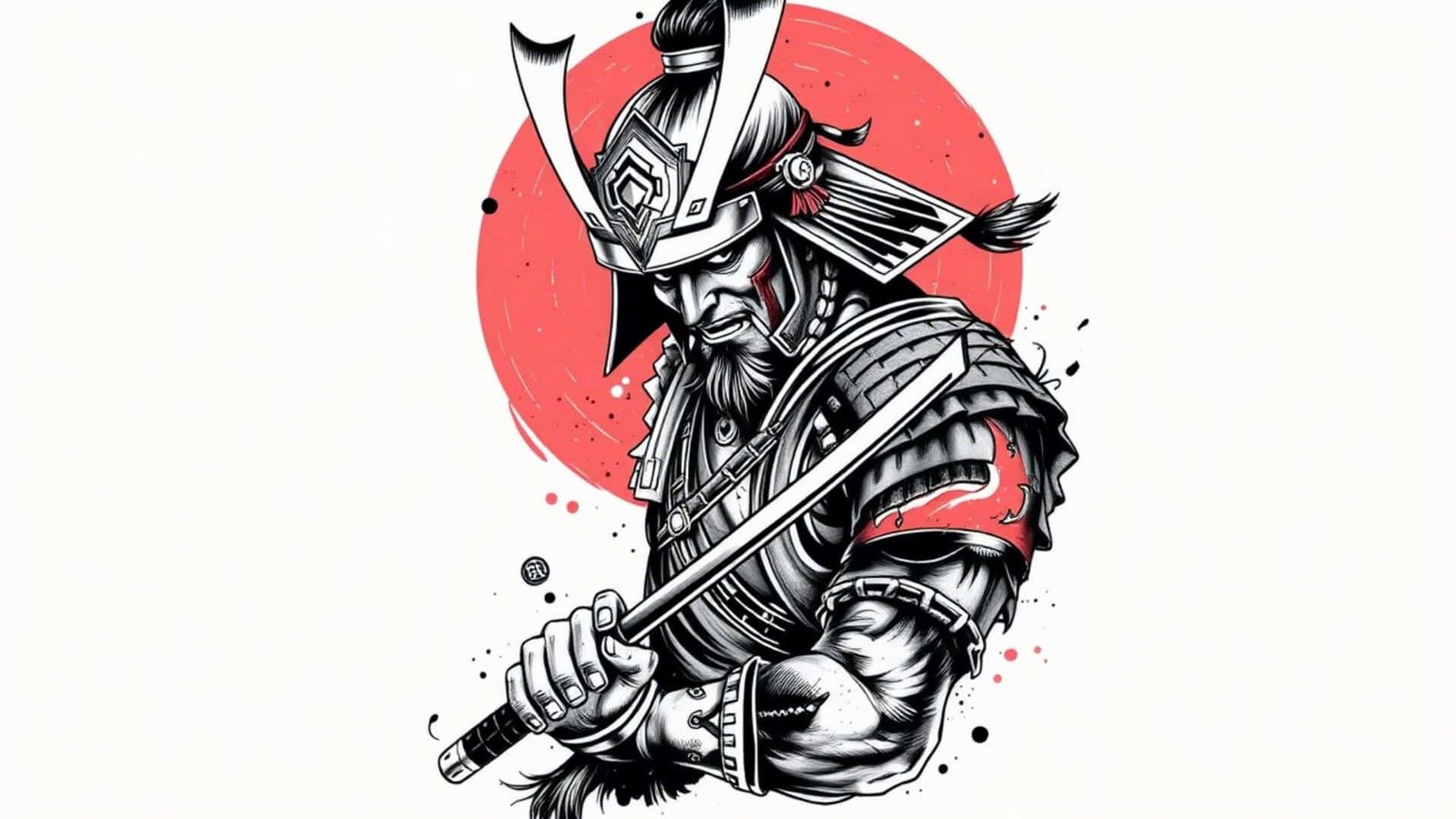The ronin samurai remains one of the most compelling figures in Japanese history and culture. These masterless warriors, stripped of their lord’s protection yet retaining their deadly skills, embody a raw contradiction that speaks to modern souls. Their stories resonate deeply with anyone who’s felt adrift in life while still possessing inner strength.
Choosing a ronin samurai tattoo isn’t just about getting inked with something that looks cool. It’s about connecting with themes of resilience, independence, and the complex nature of honor when traditional structures fall away.
The imagery carries weight that goes beyond surface aesthetics, touching on philosophical concepts that have fascinated people for centuries.
The Historical Context That Gives Meaning
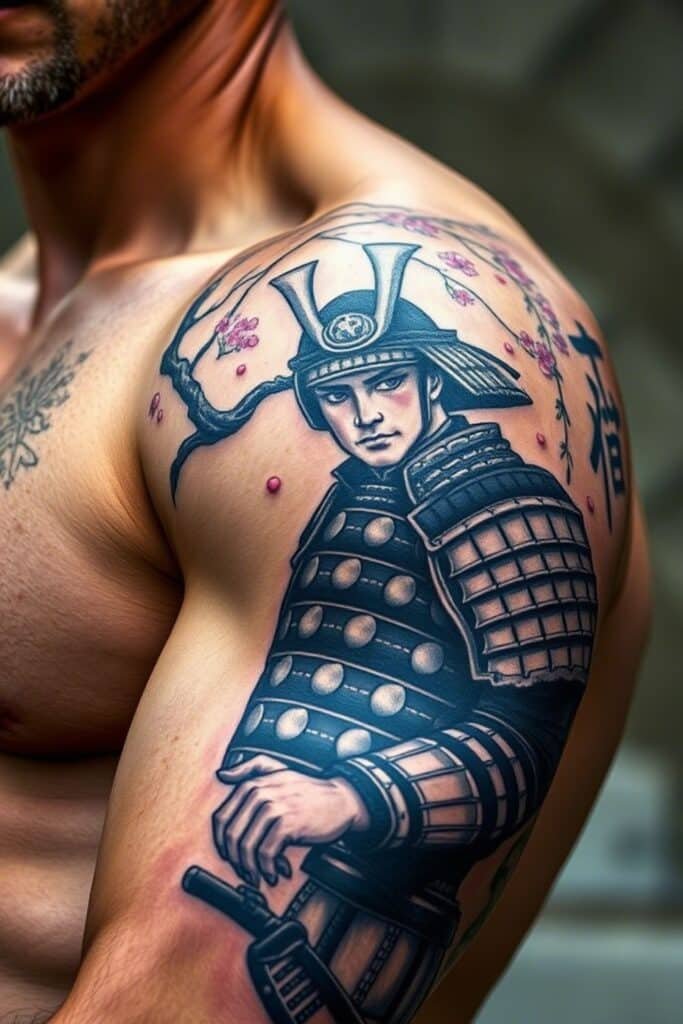
Understanding the ronin’s place in feudal Japan adds layers of meaning to any tattoo design. When a samurai’s lord died or dismissed them, they faced a choice: commit seppuku to follow their master in death, or become ronin and navigate a world that viewed them with suspicion. Most chose life, even with its accompanying shame and uncertainty.
These wandering warriors often became mercenaries, bodyguards, or even bandits. Some dedicated themselves to perfecting their martial arts in solitude. Others sought new lords to serve, though finding honorable employment proved challenging when society questioned their loyalty. The ronin’s journey became one of self-discovery and redefinition.
The most famous ronin story involves the 47 masterless samurai who spent years planning revenge for their lord’s death. Their tale of patience, sacrifice, and ultimate vindication has inspired countless adaptations. It demonstrates how ronin could transcend their outcast status through extraordinary dedication to principles that went beyond mere obedience.
Traditional Imagery and Symbolism
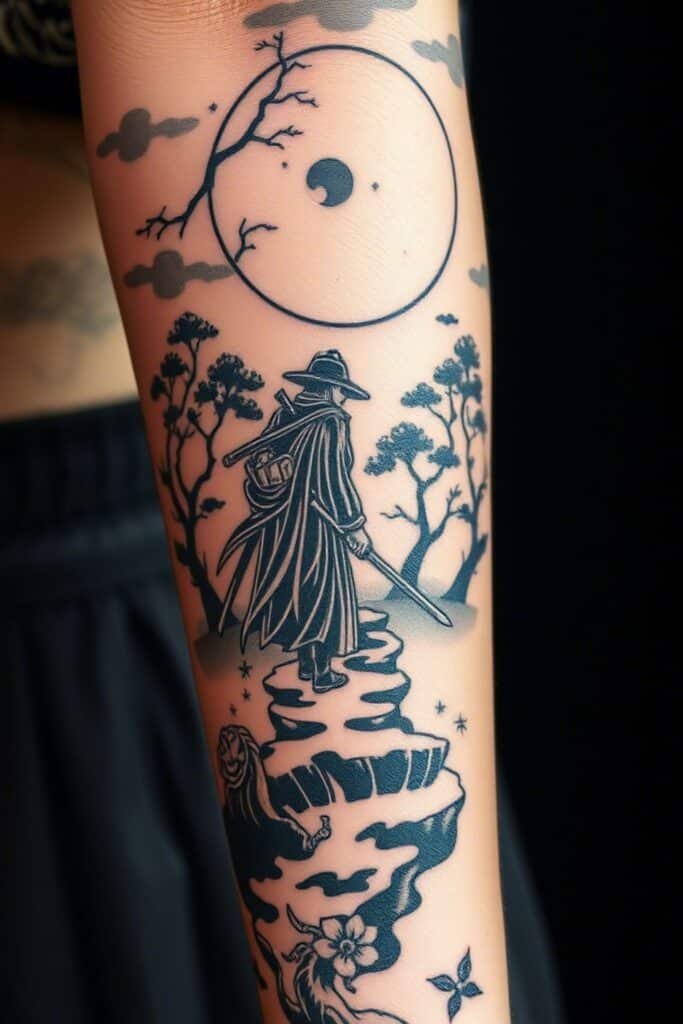
Classic ronin tattoo designs often feature the solitary warrior in travel-worn clothing. The iconic wide-brimmed hat (sugegasa) and straw raincoat (mino) became symbols of the wandering life. These elements immediately communicate the nomadic nature of the masterless samurai, creating instant visual recognition for those familiar with the archetype.
The katana remains central to most ronin designs, but its presentation differs from housed samurai depictions. Where a serving samurai’s sword represents duty and station, the ronin’s blade symbolizes self-reliance and personal honor. The weapon becomes an extension of the warrior’s individual will rather than their master’s authority.
Cherry blossoms (sakura) frequently accompany ronin imagery, their brief blooming period reflecting the transient nature of life and status. Falling petals can represent the loss of position or the acceptance of mortality. Some designs incorporate withered or storm-battered blossoms to emphasize hardship and endurance through difficult times.
Modern Interpretations and Artistic Styles
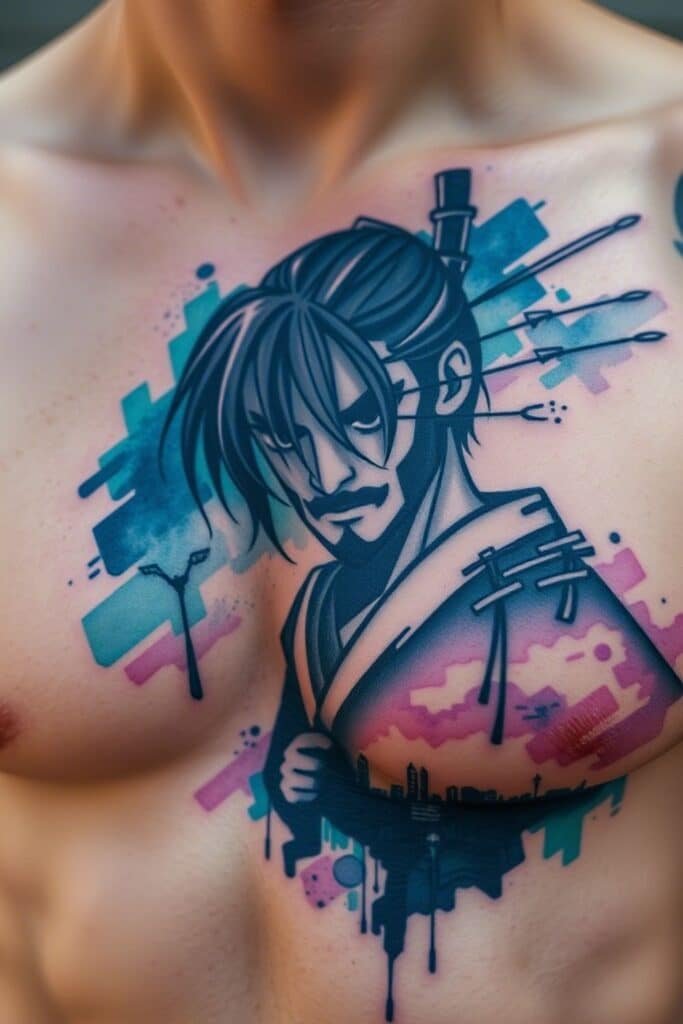
Contemporary tattoo artists have embraced the ronin concept while adapting it to modern sensibilities. Neo-traditional styles blend classical Japanese elements with bold colors and dynamic composition techniques. These pieces often feature more dramatic lighting effects and enhanced emotional expression than traditional ukiyo-e prints would typically show.
Realistic portrayals focus on weathered faces and battle-scarred hands, emphasizing the human cost of the ronin lifestyle. Artists skilled in portrait work can capture the complex emotions of pride mixed with melancholy that defines the ronin experience. The psychological depth adds personal resonance for those who identify with feelings of displacement or searching.
Minimalist approaches strip away elaborate backgrounds to focus on essential elements. A single figure silhouetted against empty space can be more powerful than busy, detailed scenes. These designs work particularly well for people who prefer subtlety or have limited space for their tattoo.
Abstract interpretations deconstruct traditional imagery into geometric patterns or flowing brushstroke-like elements. The ronin concept becomes a feeling rather than a literal representation. This approach allows for highly personalized designs that capture the emotional impact without requiring extensive knowledge of Japanese culture to appreciate.
Placement Considerations for Maximum Impact

The back offers the most canvas space for elaborate ronin scenes. Full back pieces can incorporate landscapes, weather effects, and multiple symbolic elements to create immersive compositions. The vertical orientation works naturally with standing figure poses, while the width allows for dramatic horizontal elements like wind-blown clothing or scattered leaves.
Sleeve tattoos provide opportunities for narrative storytelling across the arm’s surface. The ronin’s journey can unfold from shoulder to wrist, with different scenes representing various stages of the wandering warrior’s path. Wrap-around designs take advantage of the arm’s cylindrical shape to create dynamic movement and flow.
Chest pieces center the ronin close to the heart, emphasizing personal connection to the imagery. The broad, flat surface works well for single powerful figures or face-forward portraits. Incorporating the design across both pecs can create symmetrical compositions or contrasting scenes representing internal conflict.
Leg tattoos, particularly thigh pieces, offer substantial space while remaining easily concealed when necessary. The length of the thigh naturally accommodates full-figure ronin designs, while the muscle contours can enhance the three-dimensional appearance of the artwork.
Color Palettes That Enhance the Story
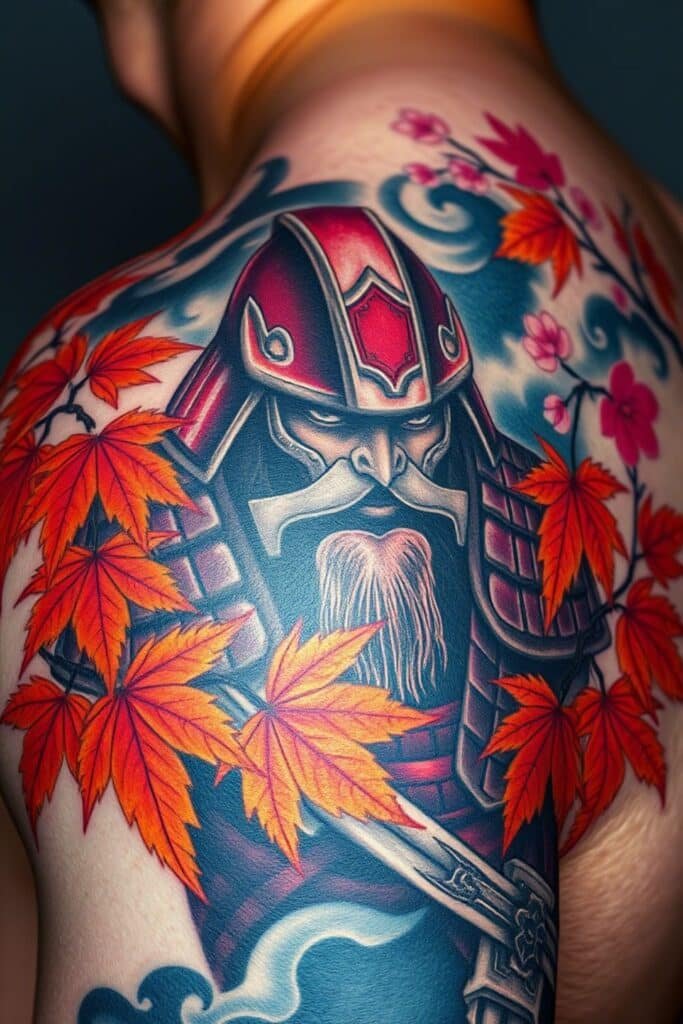
Traditional Japanese tattoo colors – deep reds, blacks, and gold accents – create authentic-feeling ronin designs. These earth tones and bold contrasts reflect the natural materials and dramatic lighting found in classical woodblock prints. The limited palette forces focus on composition and symbolism rather than relying on color variety for visual interest.
Monochromatic approaches using only black ink emphasize line work, shading, and texture. This style recalls sumi-e ink paintings and can create striking, timeless pieces. The absence of color allows subtle details and masterful shading techniques to take center stage.
Muted color schemes reflect the ronin’s often harsh living conditions. Dusty browns, weathered grays, and faded cloth colors tell stories of long travels and limited resources. These subdued palettes can create more realistic, lived-in appearances that emphasize the human struggle behind the warrior image.
Selective color use – perhaps just the red of blood on a blade or the pink of cherry blossoms – can create dramatic focal points within otherwise monochrome designs. This technique draws attention to specific symbolic elements while maintaining overall visual cohesion.
Incorporating Personal Elements

Many people adapt ronin imagery to reflect their own life experiences. Military veterans might include elements from their service branch or specific conflicts. The themes of warrior identity persisting beyond institutional structure resonate strongly with those transitioning to civilian life.
Personal symbols can be woven into traditional designs without compromising their integrity. Family crests, significant dates, or meaningful quotes in Japanese calligraphy can personalize the piece while maintaining cultural authenticity. The key lies in finding elements that complement rather than compete with the core imagery.
Geographic elements from one’s homeland can create interesting cultural fusion pieces. A ronin traversing American landscapes or European cities speaks to the universal nature of the wandering warrior archetype. These hybrid designs acknowledge personal heritage while embracing adopted philosophical concepts.
Modern professions can find parallels in the ronin experience. Freelancers, entrepreneurs, and anyone who’s left traditional employment structures might see themselves reflected in the masterless warrior’s independent path. The tattoo becomes a declaration of self-reliance and determination to forge one’s own way.
Avoiding Cultural Appropriation Pitfalls
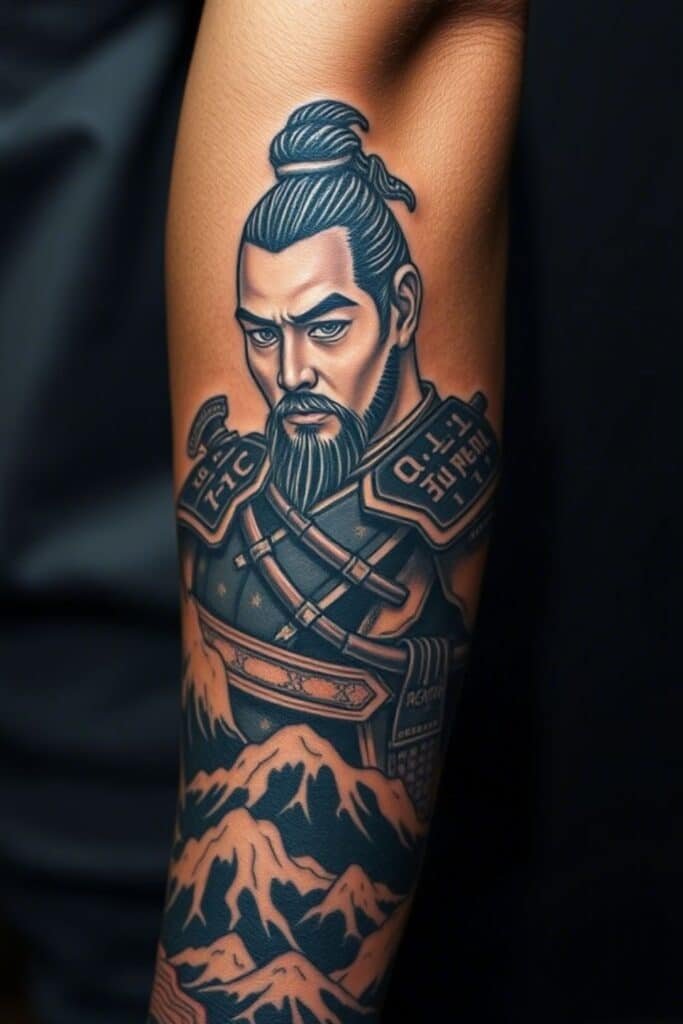
Respectful appreciation requires understanding the cultural weight behind ronin imagery. These weren’t just cool-looking warriors but real people facing genuine hardship and social stigma. Approaching the subject with reverence for its historical significance shows proper respect for Japanese culture.
Working with artists who understand Japanese tattoo traditions ensures cultural accuracy in design elements. Proper proportions, authentic details, and appropriate symbolic combinations matter for creating meaningful rather than superficial representations. Research and consultation demonstrate serious intent rather than casual adoption of foreign imagery.
Learning about the philosophical concepts underlying samurai and ronin culture adds depth to personal connection with the imagery. Bushido principles, concepts of honor and duty, and the spiritual aspects of martial arts provide context that enriches the tattoo’s personal meaning.
Avoiding stereotypical or Hollywood-influenced interpretations helps maintain cultural authenticity. Real ronin were complex individuals dealing with loss, adaptation, and survival. Their stories involve failure and redemption, making them more human and relatable than one-dimensional warrior fantasies.
Maintenance and Aging Considerations

Japanese-style tattoos often improve with age as lines soften and colors mature. The bold, flowing designs remain readable even as fine details blur slightly over time. Choosing an experienced artist familiar with how different elements age ensures the piece maintains its impact for decades.
Proper aftercare becomes crucial for preserving the intricate details common in ronin designs. Following healing protocols protects the investment in both time and money. Quality work deserves quality care to maintain its appearance and symbolic significance.
Touch-up sessions may be necessary years later to refresh colors or strengthen lines. Planning for this maintenance as part of the tattoo commitment shows respect for the artwork and its cultural origins. Well-maintained pieces honor both the artist’s skill and the imagery’s cultural heritage.
Sun protection helps preserve color vibrancy and prevents premature fading. Ronin tattoos often include subtle color gradations that can be lost to UV damage. Simple precautions ensure the piece continues telling its story effectively throughout the wearer’s lifetime.
The Psychological Impact of Ronin Imagery
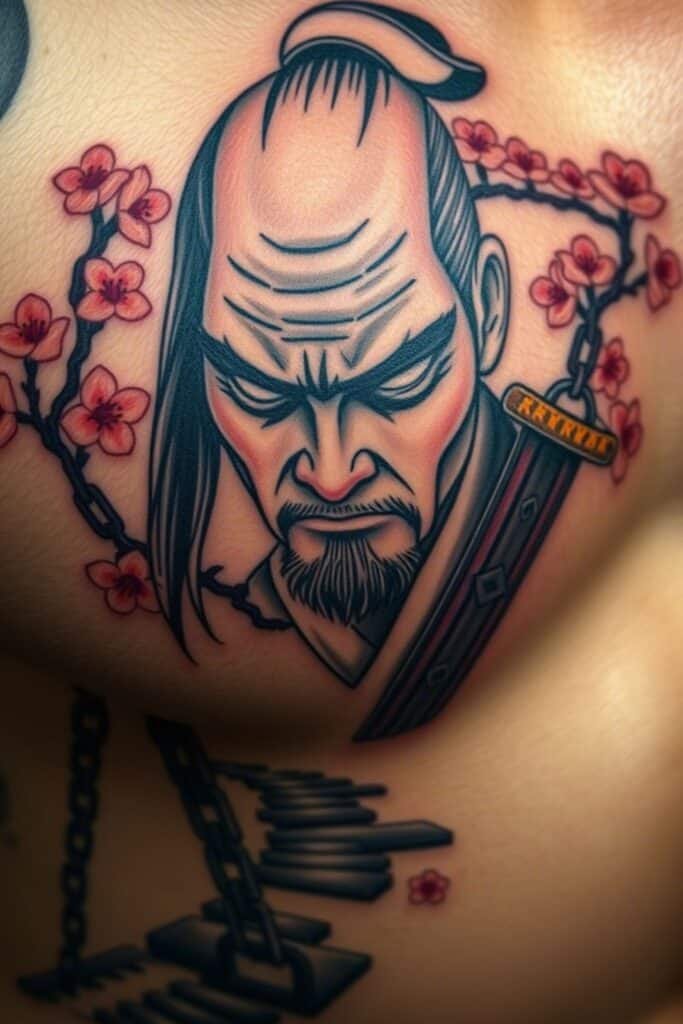
Choosing ronin imagery often reflects personal transitions or life changes. The masterless warrior becomes a symbol for navigating uncertainty while maintaining core values. People drawn to these designs frequently identify with themes of independence and self-determination.
The ronin’s story offers hope for those feeling displaced or lost. These warriors found new purposes despite losing their original identities. Their resilience in the face of social rejection provides inspiration for anyone struggling with major life changes or unconventional choices.
Wearing ronin imagery can serve as a daily reminder of inner strength and adaptability. The tattoo becomes a personal talisman encouraging perseverance through difficult times. This psychological support function adds practical value beyond aesthetic appreciation.
The commitment required for large, detailed ronin tattoos mirrors the dedication these historical figures showed in perfecting their skills. The lengthy tattoo process itself becomes a form of discipline and patience training, connecting the wearer more deeply with the warrior mindset.
Conclusion: Embracing the Ronin Path
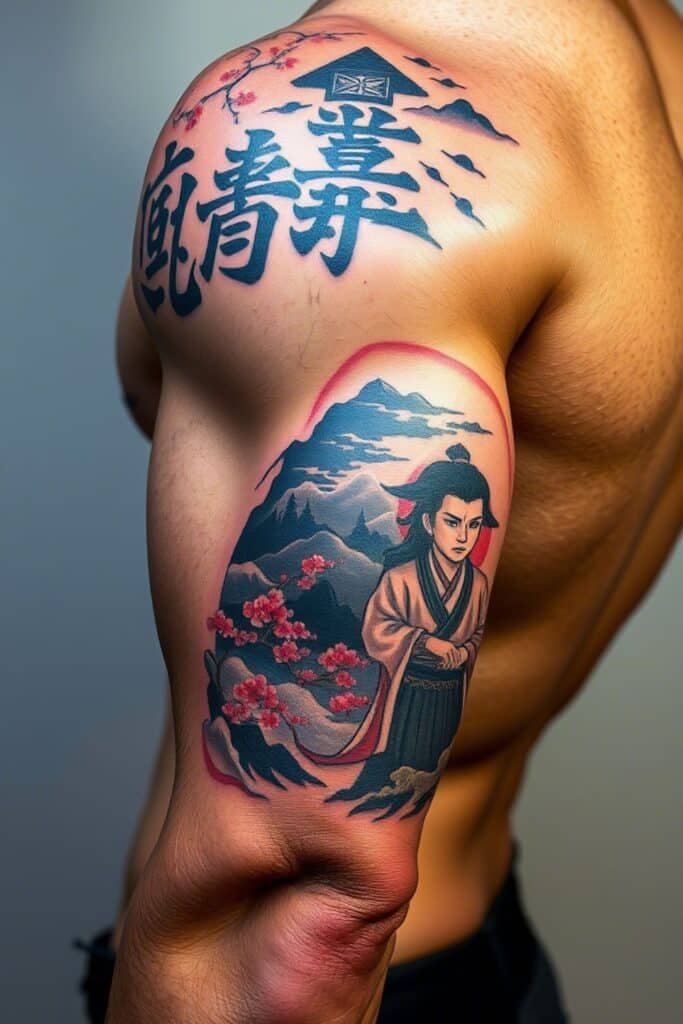
Ronin samurai tattoos offer rich opportunities for meaningful body art that goes beyond surface decoration. These designs connect wearers with centuries of Japanese culture while speaking to universal human experiences of loss, adaptation, and self-discovery. The imagery provides both visual impact and philosophical depth.
Choosing to embark on a ronin tattoo journey requires the same commitment and respect that the historical figures themselves embodied. The process demands patience, research, and collaboration with skilled artists who understand the cultural significance behind the imagery. Like the ronin’s path, it’s not a decision to make lightly.
The finished piece becomes more than decoration – it serves as a permanent reminder of personal strength and the ability to forge meaning from difficult circumstances. In wearing the ronin’s image, one carries forward their legacy of resilience and independence. The masterless warrior lives on, inspiring new generations to find their own way in an uncertain world.

Lex memn is a passionate tattoo artist and writer with 3 years of experience in the tattoo world. Dedicated to inspiring and guiding people through creative designs and meaningful tattoo ideas, Lex memn shares their expertise with readers. Explore their work and passion for ink at TifoMags!

